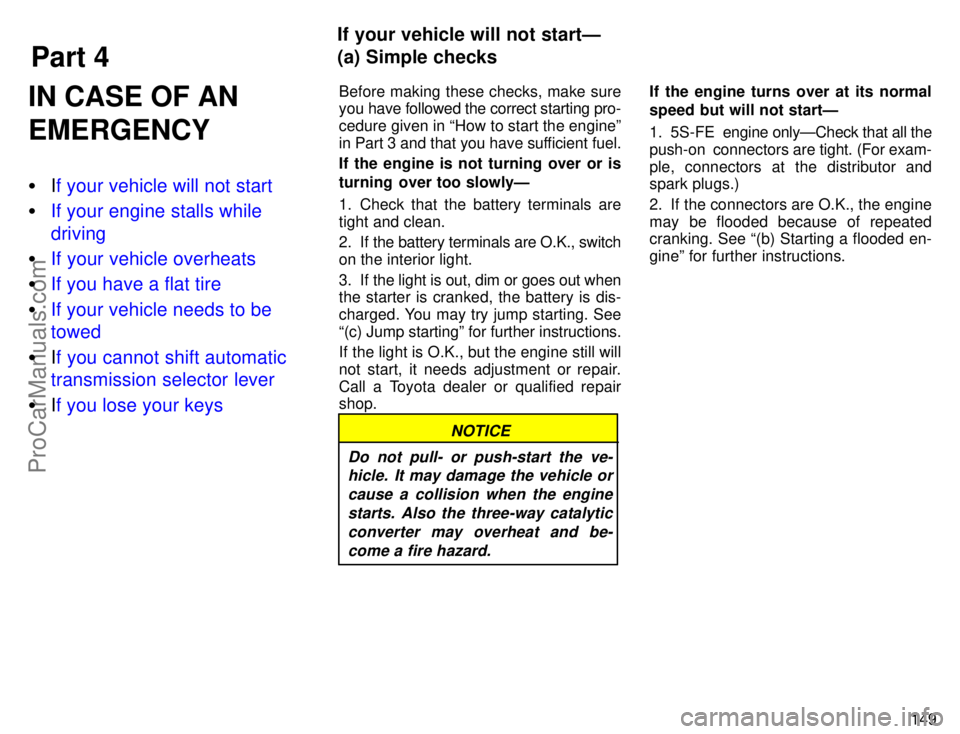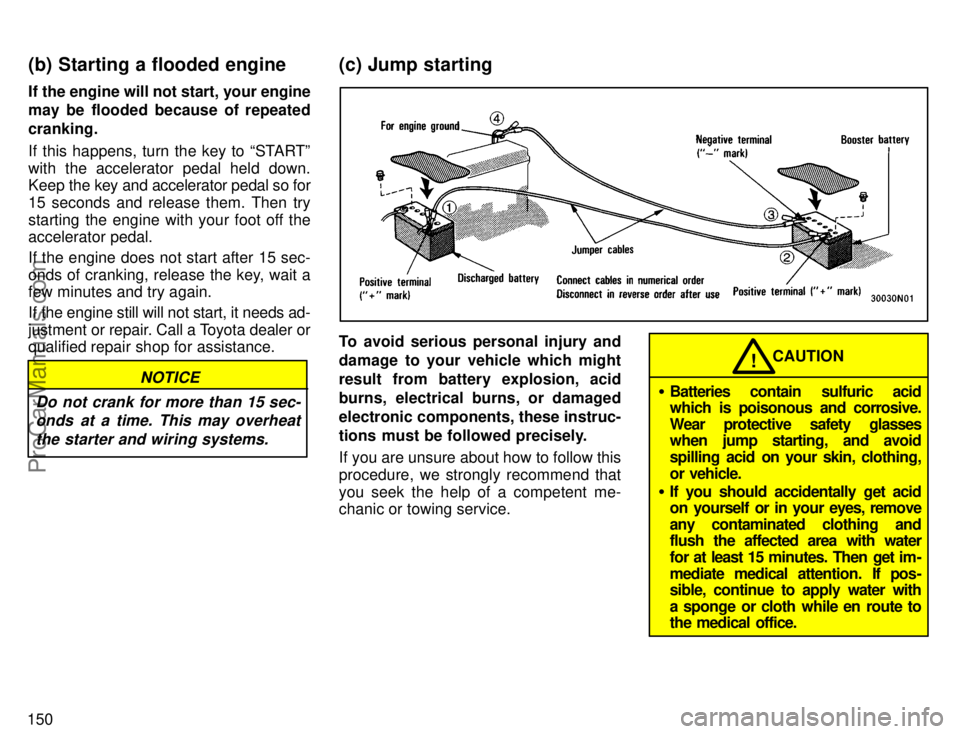Page 155 of 226

Part 4
If your vehicle will not startÐ
(a) Simple checks
149
IN CASE OF AN
EMERGENCY
�If your vehicle will not start
�If your engine stalls while
driving
�If your vehicle overheats
�If you have a flat tire
�If your vehicle needs to be
towed
�If you cannot shift automatic
transmission selector lever
�If you lose your keys
Before making these checks, make sure
you have followed the correct starting pro-
cedure given in How to start the engineº
in Part 3 and that you have sufficient fuel.
If the engine is not turning over or is
turning over too slowlyÐ
1. Check that the battery terminals are
tight and clean.
2. If the battery terminals are O.K., switch
on the interior light.
3. If the light is out, dim or goes out when
the starter is cranked, the battery is dis-
charged. You may try jump starting. See
(c) Jump startingº for further instructions.
If the light is O.K., but the engine still will
not start, it needs adjustment or repair.
Call a Toyota dealer or qualified repair
shop.
NOTICE
Do not pull- or push-start the ve-
hicle. It may damage the vehicle or
cause a collision when the engine
starts. Also the three-way catalytic
converter may overheat and be-
come a fire hazard.
If the engine turns over at its normal
speed but will not startÐ
1. 5S-FE engine onlyÐCheck that all the
push-on connectors are tight. (For exam-
ple, connectors at the distributor and
spark plugs.)
2. If the connectors are O.K., the engine
may be flooded because of repeated
cranking. See (b) Starting a flooded en-
gineº for further instructions.
ProCarManuals.com
Page 156 of 226

150If the engine will not start, your engine
may be flooded because of repeated
cranking.
If this happens, turn the key to STARTº
with the accelerator pedal held down.
Keep the key and accelerator pedal so for
15 seconds and release them. Then try
starting the engine with your foot off the
accelerator pedal.
If the engine does not start after 15 sec-
onds of cranking, release the key, wait a
few minutes and try again.
If the engine still will not start, it needs ad-
justment or repair. Call a Toyota dealer or
qualified repair shop for assistance.
NOTICE
Do not crank for more than 15 sec-
onds at a time. This may overheat
the starter and wiring systems.
To avoid serious personal injury and
damage to your vehicle which might
result from battery explosion, acid
burns, electrical burns, or damaged
electronic components, these instruc-
tions must be followed precisely.
If you are unsure about how to follow this
procedure, we strongly recommend that
you seek the help of a competent me-
chanic or towing service.
�Batteries contain sulfuric acid
which is poisonous and corrosive.
Wear protective safety glasses
when jump starting, and avoid
spilling acid on your skin, clothing,
or vehicle.
�If you should accidentally get acid
on yourself or in your eyes, remove
any contaminated clothing and
flush the affected area with water
for at least 15 minutes. Then get im -
mediate medical attention. If pos-
sible, continue to apply water with
a sponge or cloth while en route to
the medical office.CAUTION
! (b) Starting a flooded engine (c) Jump starting
ProCarManuals.com
Page 157 of 226

151
�The gas normally produced by a
battery will explode if a flame or
spark is brought near. Use only
standardized jumper cables and
do not smoke or light a match
while jump starting.
NOTICE
The battery used for boosting must
be 12 V. Do not jump start unless
you are sure that the booster battery
is correct.
JUMP STARTING PROCEDURE
1. If the booster battery is installed in
another vehicle, make sure the vehicles
are not touching. Turn off all unnecessary
lights and accessories.
2. If required, remove all the vent plugs
from the booster and discharged batter-
ies. Lay a cloth over the open vents on the
batteries. (This helps reduce the explo-
sion hazard, personal injuries and burns.)
3. If the engine in the vehicle with the
booster battery is not running, start it and
let it run for a few minutes. During jump
starting, run the engine at about 2000 rpm
with the accelerator pedal lightly de-
pressed.4. Connect the jumper cables in the exact
order shown in the illustration: positive
terminal (+º mark)-to-positive terminal
(+º mark), and negative terminal
(-º mark)-to-engine or body ground.
Note that you first connect the positive
cable to the discharged battery and then
to the booster battery. Next, connect the
negative cable to the booster battery and
then to a solid, stationary, unpainted, me-
tallic point (e.g. 5S-FE engineÐengine
hanging hook, 1MZ-FE engineÐcylinder
head) away from the battery. Do not con-
nect it to or near any part that moves when
the engine is cranked.
When making the connections, do
not lean over the battery or acciden -
tally let the jumper cables or clamps
touch anything except the correct
battery terminals or the ground.CAUTION
!
5. Start your engine in the normal way.
After starting, run it at about 2000 rpm for
several minutes with the accelerator ped-
al lightly depressed.
6. Carefully disconnect the cables in the
exact reverse order: the negative cable
and then the positive cable.
7. Carefully dispose of the battery cover
clothsÐthey may now contain sulfuric
acid.8. If removed, replace all the battery vent
plugs.
If the cause of your battery discharging is
not apparent (for example, lights left on),
you should have it checked.
ProCarManuals.com